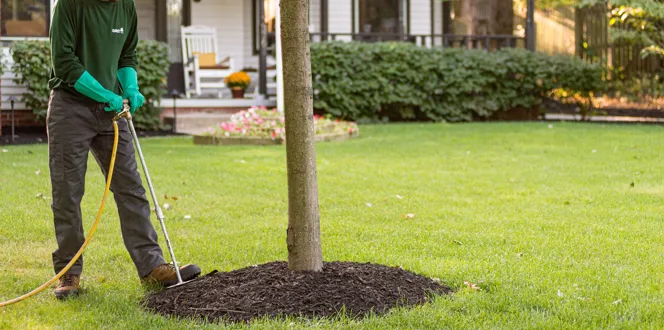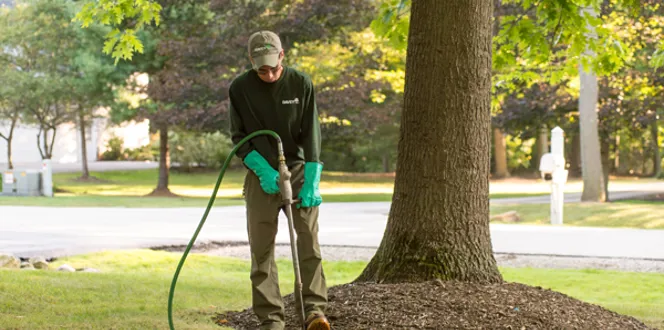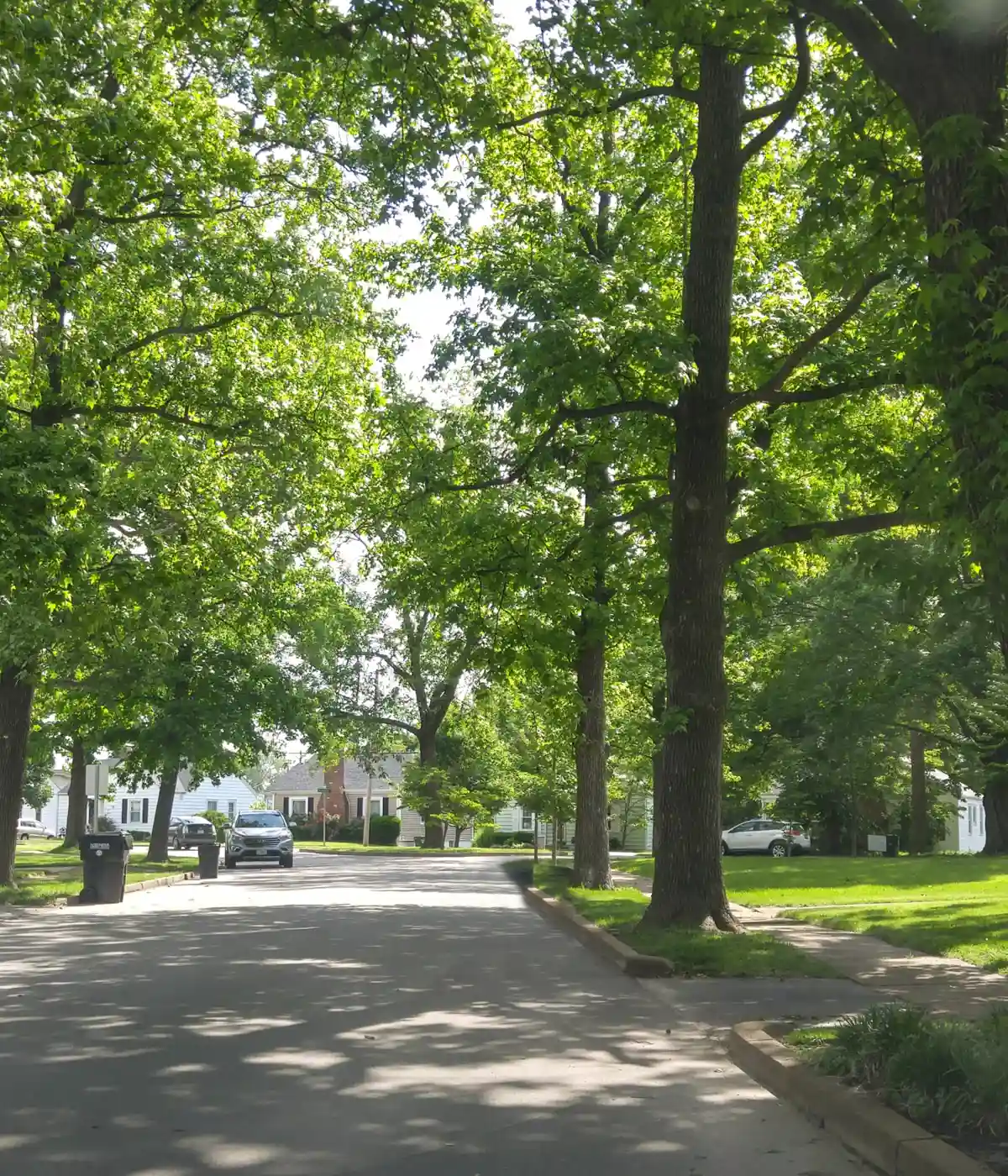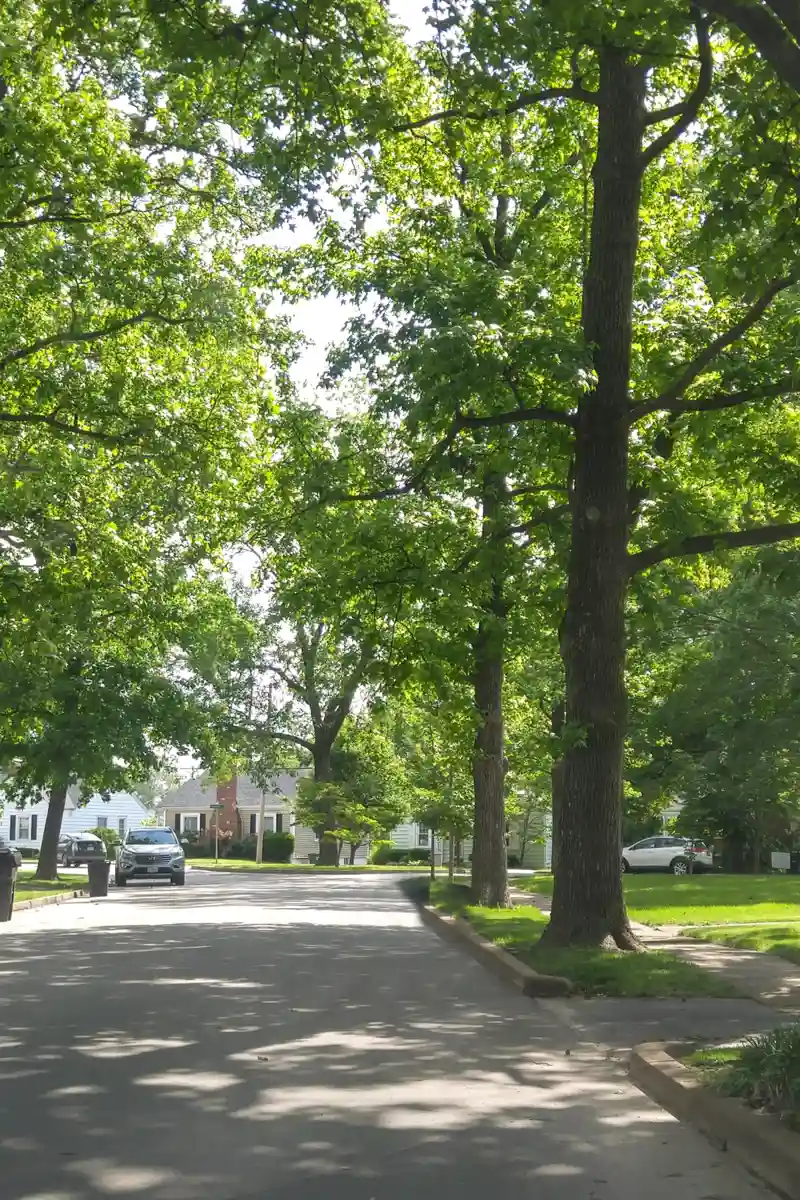Strong roots are crucial for the health and survival of a tree. They serve multiple purposes, including anchoring trees into the soil to keep them straight and stable, absorbing water, and taking in nutrients that trees need for growth, development, and repair.
During harsh winter conditions, such as plummeting temperatures, frozen ground, and heavy snow and ice, roots are at risk of injury, disrupting nutrient and water uptake that can severely affect the overall health of your trees.
One way to proactively encourage root growth is through regular fall fertilization.
How Does Fall Fertilization Help Trees Survive Winter?
While the winter doesn’t cause tree roots to become fully dormant, they do slow down growth and nutrient uptake activity. Fall’s cooler temperatures and ample moisture while the soil is still warm are optimal for root growth. This is a good time to ensure that roots have the nutrients they require to grow.
Despite popular opinion, there is no real “best time to fertilize.” Each season has its own benefits for tree root system health. Fall can be advantageous because spring and summer applications of fertilizer can exacerbate certain pests and diseases. Read more about the best way to fertilize trees here.
Key Fall Fertilization Benefits for Tree Roots
Winterizing trees through fertilization can help ensure your tree’s health through harsh weather conditions. Here are some key benefits of fertilizing your tree roots in the fall:
- Enhanced Root Development – Roots absorb and transport water and nutrients from the soil to the rest of the tree. During the fall, boosting those nutrients through fertilization ensures roots have the nutrients necessary for growth, which gives trees a better chance at surviving through the winter.
- Stress Reduction – Trees can be sensitive to stress during the cold winter months, much like they experience heat stress in the summer. Tree root system health helps trees become more tolerant of extreme temperature changes.
- Increased Disease Resistance – Healthy trees with adequate nutrition will not be under stress from nutrient deficiencies and not as vulnerable to opportunistic pests and diseases.
Choosing the Right Fertilizer for Your Trees
There is a wide variety of options when it comes to picking the best tree fertilizer for fall. You can pick fertilizers that release nutrients at different speeds, different fertilizer compositions, and more. Here are a few things to consider when choosing fertilizers:
- Slow vs. Fast Release – Much like their names suggest, slow-release fertilizer for trees will release small, steady amounts of nutrients over a period of time, while fast-release fertilizers dissolve quickly in your soil, making their nutrients instantly available to your tree.
- Get to Know Your Soil – The best options for fertilizers are based on your tree species and your soil conditions. Knowing your soil conditions from soil testing can help determine which nutrients and soil amendments are needed.
Davey’s Approach to Fall Fertilization
Professional tree fertilization services can help remove the uncertainties of fall fertilization. Davey’s customized fertilization techniques, such as deep-root fertilizations, ensure nutrients reach your tree’s roots directly.
Davey uses advanced soil testing and nutrient analysis methods to provide science-based recommendations and tailored tree care solutions to help your trees stay strong and healthy.
Common Fall Fertilization Mistakes and How to Avoid Them
Proper fertilization techniques are vital for getting the most out of your fertilizers. Here are a few common fertilizing mistakes and how to avoid them:
- Timing – Fertilizing too late in the season with excess nitrogen can encourage new growth that can be vulnerable to frost damage.
- Applying the Wrong Fertilizer – Applying fertilizer with the wrong nutrient makeup can be detrimental to your tree’s health. Understanding your tree’s nutrient requirements can help guide you to the best fertilizer for your tree’s health.
- Incorrect Application – Adding too much or too little fertilizer can cause serious harm to your trees. Make sure to follow the rates recommended by a professional.
Common Fall Fertilization Questions
A tree’s nutrient needs depend on its species. Some trees need macronutrients like nitrogen, phosphorus, and potassium, while others are often faced with a deficiency in micronutrients like zinc, manganese, or boron.
It's best to apply fertilizer late enough in the season that trees will absorb the nutrients before the ground freezes, but not so late that the ground is already frozen and tree roots slow their activity.
Tree root growth will best be promoted by correcting deficiencies as identified through soil sampling and testing. Phosphorus and potassium are usually best for tree root growth.
One fall fertilization for trees is adequate. This can be repeated every year.
USE THIS CHECKLIST TO KEEP YOUR TREES HEALTHY THIS FALL





